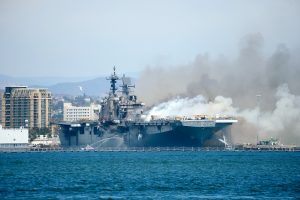A week after the burning of USS Bonhomme Richard (LHD-6), many questions remain. Some of these, involving how the fire started and how it spread, are not answerable at this point. A more intensive investigation will undoubtedly provide some results. We also do not yet know if the damage to the Bonhomme Richard will result in permanent decommissioning, although the situation does not look good. We can begin to think about what the fire means for the U.S. Navy’s force posture in the Pacific, however, and the news is not good.
The most important issues regard the relevance of the ship to the Pacific Fleet. The Bonhomme Richard was undergoing a modernization that would allow it to carry F-35Bs, which would have made it one of only four amphibious assault ships in the fleet capable of operating a fifth generation stealth fighter. Bryan McGrath offers a useful account of where the Bonhomme Richard, the anchor of an expeditionary strike group, fit into U.S. force structure in the Pacific. Essentially, the burning of the Bonhomme Richard removes an important piece from the puzzle of the Navy’s Pacific force structure, a piece that cannot be easily replaced. The loss, even if only temporary, will force the rest of the fleet to step up with longer deployments, less rest, and greater stress on both personnel and equipment.
With respect to the ship itself, while the Navy has yet to make any determination, the situation looks grim. It does not appear that the Bonhomme Richard can be economically returned to service. High heat from long-burning fires may well have caused significant structural damage that would be extremely expensive to repair. Eleven of the ship’s 14 decks have suffered fire or water damage, or both. The superstructure and some of the decks are gutted. As Jeff Schogol relates, the United States has very few areas in which it could repair the Bonhomme Richard, and no room on the construction schedule to replace it. This has sparked broader concerns about the ability of the U.S. Navy to repair battle damage on existing ships, as well as to replace any wartime losses.
More broadly, the disaster has further shaken confidence in an institution that has already suffered multiple recent setbacks. From the collisions that damaged two destroyers in the Pacific, to the Fat Leonard bribery scandal, to the failures of the first four Littoral Combat Ships and the Zumwalt-class stealth destroyers, to the ongoing technical problems with the USS Gerald Ford (CVN-78), the Navy has not done a good job of demonstrating its competence and effectiveness. This is particularly disconcerting as the U.S. Navy faces the first real peer competitor challenge since the rise of the Soviet Navy, and perhaps since the Imperial Japanese Navy. Even worse, the service may see a funding crunch necessitated by efforts to keep the U.S. economy afloat during the COVID-19 pandemic.
All told, the burning of Bonhomme Richard is a nightmare that will continue to torture the Navy for a good long while.

































